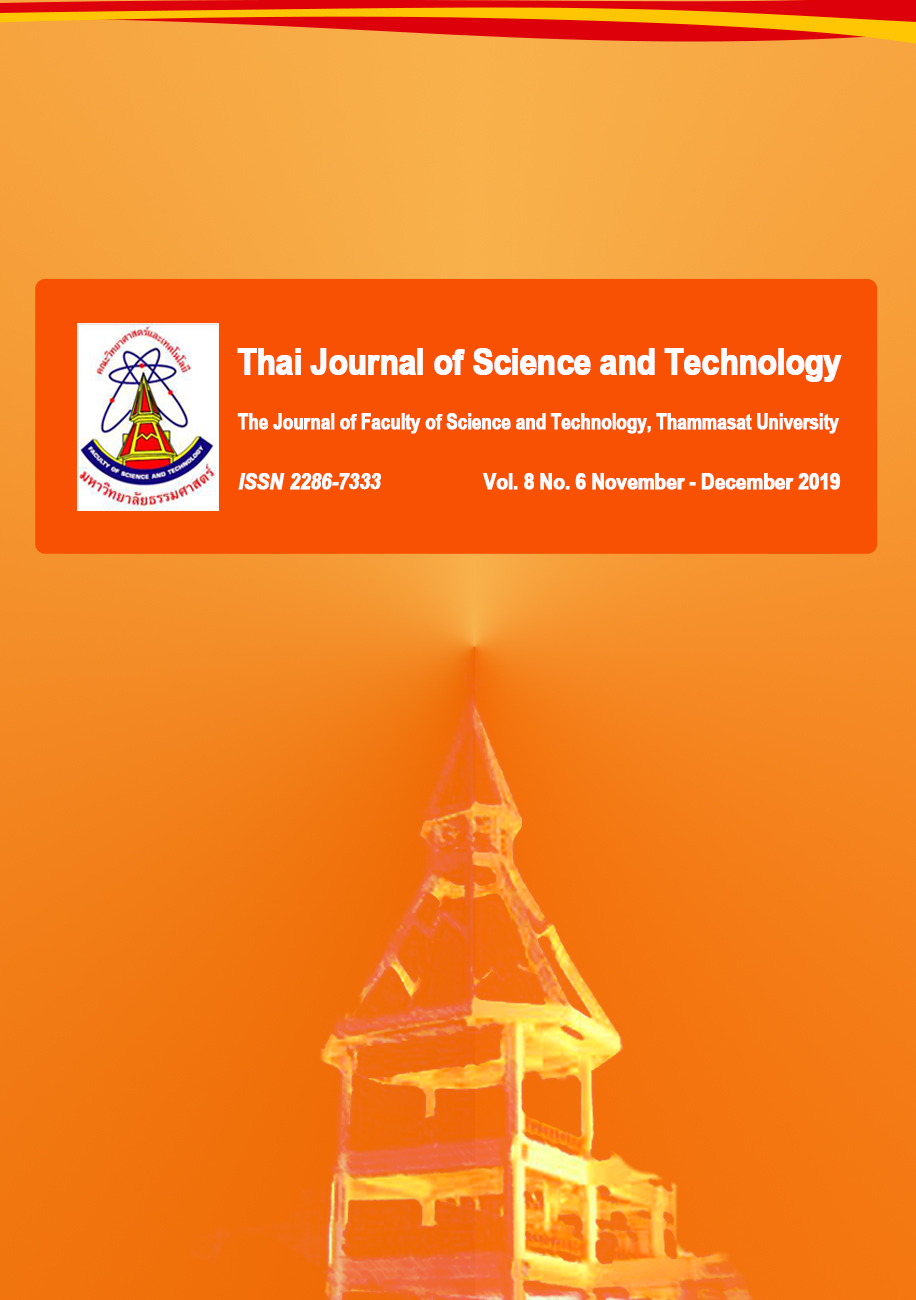การประเมินอัตราการติดเมล็ดของลูกผสมชั่วที่ 1 ระหว่างข้าวกลุ่มอินดิกากับข้าวกลุ่มอื่น
Main Article Content
Abstract
Abstract
The ability to intercross between rice subspecies in order to obtain hybrids those are not sterile and have a high seed setting rate, can be used to consider in the development of hybrid rice variety. The objective of this study was to evaluate seed setting rate of F1 hybrid from crosses between indica rice and other types. The results showed that seed setting rate of F1 hybrid obtained from cross intra-type hybrid was higher than that of inter-type hybrid. The F1 hybrid from cross indica/indica was the highest seed setting rate followed by indica/javanica, indica/NERICA, and indica/japonica. The javanica and NERICA types were combined with indica type and resulted in the F1 hybrids with ability to produce seed. Thus, utilization of heterosis by selected varieties for hybridization indica/javanica or indica/NERICA was an alternative way to solve low seed setting rate in F1 hybrid of cross indica/japonica.
Keywords: hybrid rice; seed setting rate; wide compatibility
Article Details
บทความที่ได้รับการตีพิมพ์เป็นลิขสิทธิ์ของคณะวิทยาศาสตร์และเทคโนโลยี มหาวิทยาลัยธรรมศาสตร์ ข้อความที่ปรากฏในแต่ละเรื่องของวารสารเล่มนี้เป็นเพียงความเห็นส่วนตัวของผู้เขียน ไม่มีความเกี่ยวข้องกับคณะวิทยาศาสตร์และเทคโนโลยี หรือคณาจารย์ท่านอื่นในมหาวิทยาลัยธรรมศาสตร์ ผู้เขียนต้องยืนยันว่าความรับผิดชอบต่อทุกข้อความที่นำเสนอไว้ในบทความของตน หากมีข้อผิดพลาดหรือความไม่ถูกต้องใด ๆ
References
Aggarwal, R.K., Shenoy, V.V., Ramadevi, J., Rajkumar, R. and Singh, L., 2002, Molecular characterization of some Indian Basmati and other elite rice genotypes using fluorescent-AFLP, Theor. Appl. Genet. 105: 680-690.
Araki, H., Toya, K. and Ikehashi, H., 1988, Role of Wide Compatibility Genes in Hybrid Rice Breeding, pp. 79-83, in Hybrid Rice, International Rice Research Institute, Los Baños.
Chen, J., Ding, J., Ouyang, Y., Du, H., Yang, J., Cheng, K., Zhao, J., Qiu, S., Zhang, X. and Yao, J., 2008, A triallelic system of S5 is a major regulator of the reproductive barrier and compatibility of indica-japonica hybrids in rice, Proc. Natl. Acad. Sci. 105: 11436-11441.
Chen, L.Y., Xiao, Y.H., Tang, W.B. and Lei, D.Y., 2007, Practices and prospects of super hybrid rice breeding, Rice Sci. 14: 71-77.
Chen, L., Zhao, Z., Liu, X., Liu, L., Jiang, L., Liu, S., Zhang, W., Wang, Y., Liu, Y. and Wan, J., 2011, Marker-assisted breeding of a photoperiod-sensitive male sterile japonica rice with high cross-compatibility with indica rice, Mol. Breeding 27: 247-258
Glaszmann, J.C., 1987, Isozymes and classification of Asian rice varieties, Theor. Appl. Genet. 74: 21-30.
Ikehashi, H. and Araki, H., 1986, Genetics of F1 sterility in remote crosses of rice, pp. 119-130, in Rice Genetics, International Rice Research Institute, Los Baños.
Jain, S., Jain, R.K. and McCouch, S.R., 2004, Genetic analysis of Indian aromatic and quality rice (Oryza sativa L.) germplasm using panels of fluorescently-labeled microsatellite markers, Theor. Appl. Genet. 109: 965-977.
Khush, G.S., 2005, What it will take to feed 5.0 billion rice consumers in 2030, Plant Mol. Biol. 59: 1-6.
Liu, K.D., Zhou, Z.Q., Zu, C.G., Zhang, Q. and Maroof M.A., 1996, An analysis of hybrid sterility in rice using a diallel cross of 21 parents involving indica, japonica and wide compatibility cultivars, Euphytica 90: 257-280.
Nagaraju, J., Kathirvel, M., Ramesh Kumar, R., Siddiq, E.A. and Hasnain, S.E., 2002, Genetic analysis of traditional and evolved Basmati and non-Basmati rice varieties by using fluorescence-based ISSR-PCR and SSR markers, Proc. Nat. Acad. Sci. USA 99: 5836-5841.
Najeeb, S., Ashraf Ahangar, M. and Dar, S.H., 2013, An analysis of hybrid sterility in rice (Oryza sativa L.) using genetically diverse germplasm under temperate ecosystem, Afr. J. Agric. Res. 8: 3820-3827.
Peng, S., Khush, G.S., Virk, P., Tang, Q. and Zou, Y., 2008, Progress in ideotype breeding to increase rice yield potential, Field Crops Res. 108: 32-38.
Samado, E.A., Guei, R.G. and Nguyen, N., 2008, NERICA: Origin, Nomenclature and Identification Characteristics, pp. 10-18, in Somado, E.A., Guei, R.G. and Keya, S.O. (Eds.), NERICA: The New Rice for Africa – A Compendium, Cotonou, Benin.
Smith, C.W. and Dilday, R.H., 2002, Rice: Origin, History, Technology, and Production, John Wiley and Sons, Inc., Hoboken.
Virmani, S.S., Viraktamath, B.C., Casal, C.L.,
Toledo, R.S., Lopez, M.T. and Manalo, J.O., 1997, Hybrid Rice Breeding Manual, International Rice Research Institute, Los
Baños.
Worede, F., Sreewongchai, T., Phumichai, C. and Sripichitt, P., 2013, Genetic diversity analysis of rice cultivars from various origins using simple sequence repeat (SSR) markers, Afr. J. Biotechnol. 12: 4074-4081.
Yaun, L., 2003, Recent Progress in breeding super hybrid rice in China, pp. 231-236. In Lu, Y.X. (Ed.), Science Progress in China, Elsevier Science, Ltd., Oxford.
Yaun, L., 2017, Progress in super-hybrid rice breeding, Crop J. 5: 100-102.
Ying, J., Peng, S., He, Q., Yang, H., Yang, C., Visperas, R.M. and Cassman, K.G., 1998, Comparison of high-yield rice in tropical and subtropical environments: I. Determinants of grain and dry matter yields, Field Crops Res. 57: 71-84
Zhang, Q.F., Maroof, M.A.S., Lu, T.Y. and Shen, B.Z., 1992, Genetic diversity and differentiation of indica and japonica rice detected by RFLP analysis, Theor. Appl. Genet. 83: 495-499.


